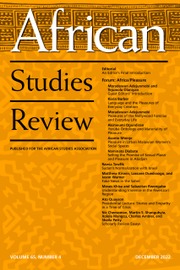Article contents
You are where you build: Hierarchy, Inequality, and Equalitarianism in Mandara Highland Architecture
Published online by Cambridge University Press: 11 February 2019
Abstract:
Ethnic groups living in the Mandara Mountains are assumed to be segmentary in structure, which is why scholarly literature portrays them as egalitarian societies. The configuration of the architectural landscape reveals a different reality. This article shows how the architectural landscapes of the Mandara Highlands are ideologically constructed to represent and legitimize hierarchies between clans and individuals. Physical entities appear as particular elements of social space, and as places socially constructed and tinged with ideologies. These fieldwork-based observations provide the foundation for interrogating the meaning of egalitarianism in African society.
Résumé:
Les groupes ethniques vivant dans les Monts Mandara apparaissent comme des sociétés segmentaires de par leur structure sociale. C’est pourquoi la littérature scientifique les a dépeint comme des sociétés égalitaires. Cependant, la configuration du paysage architectural révèle une réalité très différente et met en lumière des phénomènes sociaux cachés. Cet article vise à montrer comment les paysages architecturaux des Monts Mandara sont idéologiquement construits pour représenter et légitimer les hiérarchies entre les clans et les individus. Entités physiques, certes, ils apparaissent comme des éléments particuliers de l’espace social et idéologiquement teintés. En tant qu’espaces construits, ils sont créés avec des pierres, du chaume et de l’argile ; mais comme `espace social’, ils revêtent des significations qui concrétisent et rendent légitime l’accès inégal aux ressources politiques et sacrées. Ces observations portées sur la structure du paysage conduisent à une question fondamentale : les groupes sociaux vivant dans les Monts Mandara sont-ils des sociétés égalitaires ? Si la hiérarchie signifie l’existence d’inégalités entre les individus, il serait inapproprié de qualifier ces sociétés d’égalitaires tant on y constate l`existence des inégalités d’accès aux ressources matérielles et aux positions sociales honorables. A partir de ces constats, cet article fait valoir l’argument qu’hiérarchie et égalité coexistent dans un même système, tant les accents égalitaires s’interpénètrent avec une recherche ostentatoire de prestige personnel, notamment à travers l’espace bâti.
Resumo:
A estrutura dos grupos étnicos que habitam os Montes Mandara tem sido considerada como sendo segmentária, razão pela qual a literatura académica retrata estes grupos como sociedades igualitárias. No entanto, a configuração da paisagem arquitetónica indicia uma realidade diferente. O presente artigo explica de que modo as paisagens arquitetónicas das Terras Altas de Mandara são ideologicamente construídas para representar e legitimar as hierarquias entre clãs e indivíduos. As estruturas físicas constituem elementos específicos do espaço social e lugares socialmente construídos, eivados de ideologias. Resultantes de um trabalho de campo, as observações aqui reunidas lançam as bases para questionarmos o significado do igualitarismo na sociedade africana.
Keywords
Information
- Type
- Article
- Information
- Copyright
- Copyright © African Studies Association 2019
References
- 15
- Cited by

